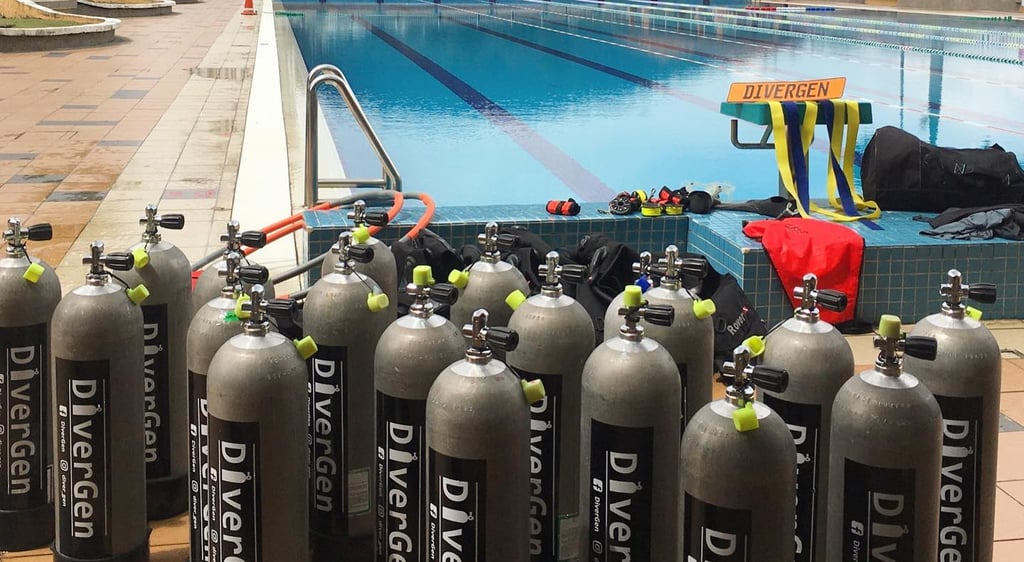Gear Up: Essential Scuba Diving Equipment Guide
Get ready to dive with confidence! This quick guide covers the must-have scuba gear, helping you choose the right equipment for a safe and enjoyable underwater adventure. Perfect for both beginners and seasoned divers.
DIVE TIPS
Author: SNO
8/12/20246 min read


Are you ready to dive into the deep blue and explore the wonders of the underwater world? Before you take the plunge, it’s crucial to ensure you have the right gear to make your scuba diving adventure safe, enjoyable, and unforgettable. Whether you're a beginner or looking to upgrade your existing equipment, this comprehensive guide will walk you through the essential scuba gear you need to dive like a pro. From the fins that propel you through the water to the wetsuit that keeps you warm, we’ve got everything covered to help you gear up for an incredible underwater experience.
Getting to Know Your Scuba Gear: The Basics
Understanding the Essentials
Scuba diving is an incredible adventure, but to fully enjoy the experience, having the right equipment is key. The right gear not only enhances your comfort and performance but also plays a critical role in ensuring your safety underwater. The equipment you choose can make or break your diving experience, so it's important to invest in high-quality gear that suits your needs. This guide will introduce you to the fundamental components of scuba diving equipment, helping you make informed decisions as you prepare for your underwater adventures.
The Importance of Proper Fit
When it comes to scuba gear, fit is everything. Ill-fitting equipment can lead to discomfort, reduced performance, and even safety risks. Whether you’re selecting a wetsuit, fins, or a mask, ensuring that your gear fits properly is crucial. Always try on equipment before purchasing and make sure it feels comfortable and secure. Remember, what works for one diver might not work for another, so take the time to find gear that fits your body and diving style.
Picking the Perfect Wetsuit: Your Underwater Armor
Why the Right Wetsuit Matters
Your wetsuit is more than just a piece of clothing—it’s your underwater armor. It protects you from the cold, sun, and marine life, while also helping you maintain buoyancy. Choosing the right wetsuit is essential for staying comfortable and safe during your dives. The thickness of the wetsuit, the material it’s made from, and how it fits your body all play important roles in determining its effectiveness.
Wetsuit Thickness: Finding the Balance
Wetsuits come in various thicknesses, typically ranging from 2mm to 7mm. The thickness you choose depends on the water temperature where you’ll be diving. For warm waters, a thinner wetsuit (2mm-3mm) will provide enough insulation while allowing for greater flexibility. In colder waters, a thicker wetsuit (5mm-7mm) is necessary to keep your body warm. Keep in mind that thicker wetsuits offer more insulation but can be more restrictive, so finding the right balance is key.
Material Matters: Neoprene and Beyond
Most wetsuits are made from neoprene, a synthetic rubber that is durable, flexible, and provides excellent insulation. Neoprene wetsuits come in different grades, with higher-quality neoprene offering better warmth and flexibility. Some wetsuits also feature additional linings, such as titanium or fleece, to enhance warmth and comfort. When choosing a wetsuit, look for one that is made from high-quality neoprene and has a smooth, comfortable lining.
The Perfect Fit: Comfort and Mobility
A good wetsuit should fit snugly without being too tight. It should allow you to move freely while keeping water from entering. A well-fitting wetsuit should feel like a second skin, with no gaps around the wrists, ankles, or neck. Remember that wetsuits can stretch slightly over time, so it’s better to choose one that is a bit snug rather than too loose. A proper fit not only keeps you warm but also enhances your mobility underwater, making your dives more enjoyable.
Fins: Your Underwater Speed Boosters
Why Fins Are Important
Fins are your underwater propulsion system, allowing you to move efficiently through the water with minimal effort. The right pair of fins can make a significant difference in your diving experience, reducing fatigue and increasing your ability to explore the underwater environment. There are several types of fins available, each designed for different diving conditions and preferences.
Types of Fins: Full-Foot vs. Open-Heel
Fins come in two main types: full-foot fins and open-heel fins. Full-foot fins are worn like shoes, covering your entire foot. They are lightweight and ideal for warm water diving where you won’t need to wear booties. Open-heel fins, on the other hand, have an adjustable strap that allows you to wear them with booties, making them more versatile for different water temperatures and conditions. Open-heel fins are generally more durable and provide better power, making them a popular choice for most divers.
Blade Design: Speed and Efficiency
The design of the fin blade plays a crucial role in determining how fast and efficiently you can swim. Fins with longer, stiffer blades provide more power and are ideal for strong currents or long-distance swimming. However, they require more leg strength. Fins with shorter, more flexible blades are easier to kick and are better suited for relaxed, easy diving in calm waters. Some fins also feature split blades or channels that reduce drag and increase propulsion, offering a balance between power and ease of use.
Choosing the Right Fins for You
When choosing fins, consider the type of diving you’ll be doing, your leg strength, and your swimming style. Try on different fins to see how they feel and how well they fit. Remember that comfort is key—ill-fitting fins can cause blisters and discomfort during your dive. A good pair of fins should feel secure on your feet and allow you to swim smoothly and efficiently.
Regulators: Your Underwater Breathing Buddy
The Role of the Regulator
The regulator is your lifeline underwater, allowing you to breathe from your scuba tank. It reduces the high-pressure air from the tank to a breathable pressure and delivers it to you through a mouthpiece. Choosing a reliable, high-quality regulator is essential for ensuring your safety and comfort during your dives.
Features to Look For
When selecting a regulator, consider features such as adjustable airflow, which allows you to control how easily you can breathe, and environmental sealing, which protects the regulator from cold water or contaminants. Look for a regulator with a comfortable mouthpiece and durable construction. Some regulators also come with additional features like venturi switches, which help optimize airflow, and balanced first and second stages, which provide consistent breathing performance at different depths.
Maintenance and Care
Proper maintenance of your regulator is crucial to ensure it functions correctly and lasts for many years. After each dive, rinse your regulator thoroughly with fresh water to remove salt and debris. Store it in a cool, dry place, away from direct sunlight. Have your regulator serviced regularly by a qualified technician to keep it in top condition. Taking care of your regulator not only extends its lifespan but also ensures that it will perform reliably when you need it most.
Dive Computers: Your Dive Dashboard
Why You Need a Dive Computer
A dive computer is an essential piece of equipment that helps you monitor key information during your dive, such as depth, dive time, and no-decompression limits. It provides real-time data that helps you plan and execute your dives safely, reducing the risk of decompression sickness and other dive-related issues.
Choosing the Right Dive Computer
When selecting a dive computer, consider factors like ease of use, readability, and connectivity. Some dive computers are wrist-mounted, while others are integrated into your console. Look for a model with a clear display, intuitive controls, and features that suit your diving style, such as nitrox compatibility, air integration, and multi-gas support. Some dive computers also offer advanced features like digital compasses, heart rate monitors, and GPS tracking.
Logging and Analyzing Your Dives
Many modern dive computers can connect to your smartphone or computer, allowing you to log and analyze your dives. This feature is useful for tracking your progress, reviewing your dive profiles, and planning future dives. By keeping a detailed log of your dives, you can learn from your experiences and improve your diving skills over time.
Keeping Your Gear in Tip-Top Shape
The Importance of Gear Maintenance
Proper maintenance of your scuba gear is essential for ensuring its longevity and performance. After each dive, rinse all your equipment with fresh water to remove salt, sand, and chlorine. Pay special attention to your regulator, wetsuit, and dive computer, as these items are particularly vulnerable to damage if not properly cared for. Allow your gear to dry completely before storing it in a cool, dry place, away from direct sunlight.
Regular Inspections and Servicing
Regularly inspect your gear for signs of wear and tear, such as frayed straps, cracked seals, or damaged zippers. Address any issues promptly to prevent them from worsening. Additionally, have your regulator, BCD, and dive computer serviced by a qualified technician at least once a year, or as recommended by the manufacturer. Proper maintenance not only ensures your safety but also enhances the performance of your equipment, allowing you to dive with confidence.
Conclusion: Dive Into Your Next Adventure with DiverGen
Having the right scuba gear is essential for making your dives safe, enjoyable, and memorable. From selecting the perfect wetsuit to choosing the right dive computer, every piece of equipment plays a crucial role in your underwater adventures. By following this guide and making informed choices, you can gear up with confidence and dive into the wonders of the ocean.
Ready to take the plunge? Join us at DiverGen and explore the underwater world like never before. Whether you're a newbie or a seasoned diver, we have everything you need to make your diving experiences unforgettable. Dive in with us and discover the ocean’s beauty, mystery, and excitement. Your next great adventure is just a breath away—happy diving!


Explore
Premier provider of scuba diving experiences and professional courses.
Passion
Ocean
diverlogyventures@gmail.com
+6012-2234432
© 2024 Diverlogy ventures (NS0302402-A) . All rights reserved.

